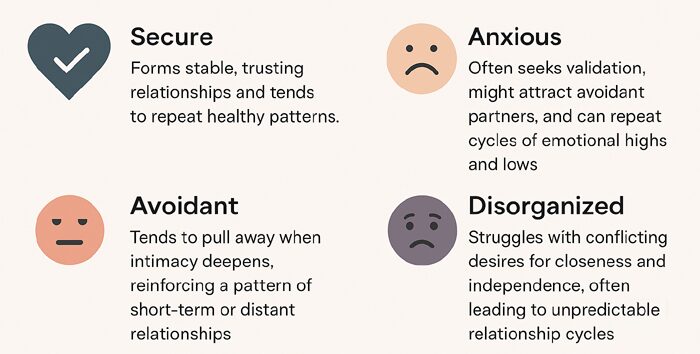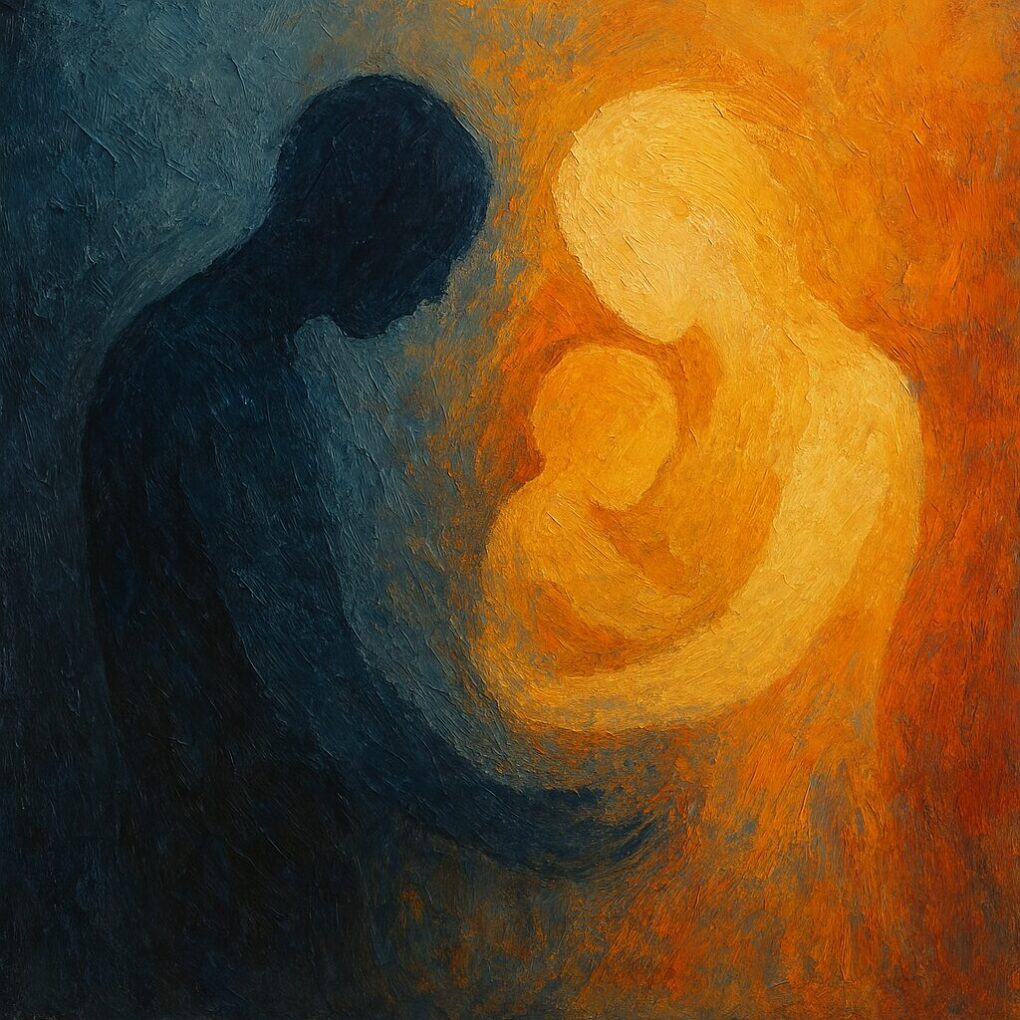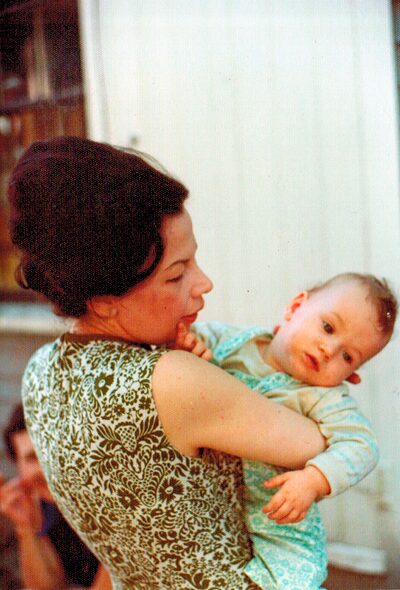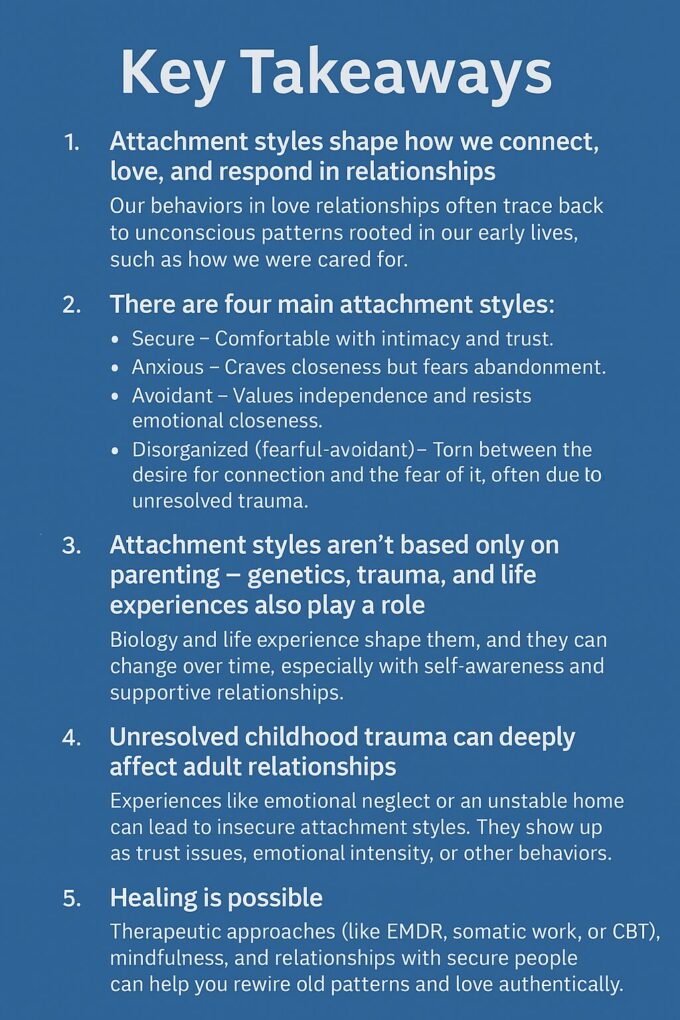- What Influences Our Relationship Patterns?
- The Link Between Attachment Styles in Relationships and Love
- The Origin of Attachment Styles in Relationships
- How Childhood Trauma Shapes Your Attachment Styles in Relationships
- How Unresolved Childhood Trauma Affects Love Relationships
- Common Types of Trauma and Their Effect on Adult Love Relationships
- Healing From Attachment Trauma, PTSD, and C-PTSD
- When to Seek Support and What You Can Do Next

When I was in a situationship, my partner mirrored me in ways I was blind to — I didn’t see how attachment styles in relationships molded our behavior.
So, when I’d avoid hard truths and he’d backpedal, I thought he was the problem. But when I looked closer, I saw myself saying “yes” when I sometimes meant “no.” Or I’d act like I didn’t care, then obsess over him.
I also didn’t know how the sting of being ignored echoed old goodbyes. Nor did I realize my need to stay in control hid a fear of being left behind again.
What Influences Our Relationship Patterns?
If you keep replaying the same scene with different names or fighting familiar battles and feel the same ache, you might not only be reacting. Your attachment style could be pulling the strings from behind the scenes.
But it might not be the sole factor. The many influences on our love maps include everything from our genetics, personalities, and culture to past trauma and relationship experiences. Some aspects play a bigger role than others.
For some, attachment styles and trauma are linked, leaving a major imprint on their relationship patterns:
- Attachment trauma consists of deep-seated wounds caused by inconsistent or harmful caregiving early on.
- Repeated or severe distress can also lead to post-traumatic stress disorder (PTSD) or complex PTSD (C-PTSD), which make trust, intimacy, and controlling emotions harder.
Our past and survival instincts have shaped who we are now. When you look in the rearview mirror, you can see where things went wrong, like how your personality and temperament influence who you attract and who you’re drawn to.
It also helps you learn how that essence influences your views about love. Unless you truly know yourself, when you’re dating, you might not always feel safe showing up as who you really are to build more secure, meaningful connections.
The Link Between Attachment Styles in Relationships and Love
Our attachment style is a core part of our internal love map — our unconscious blueprint for our romantic relationships.
Adults show patterns of attachment to their romantic partners similar to those of children with their parents.
If your parents or caregivers didn’t show you love consistently, you might seek validation in your adult romantic relationships at the cost of stability. If parental love felt conditional (like a reward for good behavior), you could fear closeness or a loss of independence.
The Origin of Attachment Styles in Relationships
Researchers once thought adult attachment styles in relationships stemmed mainly from how we were raised — whether a parent showed up when we cried or left us waiting, unsure of their arrival. But we now also know other forces affect how we bond, too, like genetics and life experiences (“Attached”).
“True love, in the evolutionary sense, means peace of mind.”
~ “Attached” by Amir Levine and Rachel Heller
In prehistoric times, being alone often increased your risk of death from predators or other dangers. Those with protective partners were more likely to survive and pass on the instinct to seek a connection. Our brains still run on these instincts. Our attachment system might flare when we’re separated from someone we depend on — an emotional and biological response tied to our survival.
Relationship Attachment Styles Defined
Many of us, whether we’re new to dating or have been partnered for years, can fall under one of these categories:
🥰 Secure attachment (responsive parenting): Forms stable, trusting relationships. People with this attachment style feel comfortable with intimacy and are usually warm and loving.
😟 Anxious attachment (inconsistent care): Often seeks validation, might attract avoidant partners, and can repeat cycles of emotional highs and lows. These types tend to sense more subtle details other attachment styles might overlook and take longer to process them (1).
- They crave intimacy, are often preoccupied with their relationships, or worry about their partner’s ability to love them back. For the anxiously attached, the “push-pull” cycle of the avoidant, who moves closer when they feel safe and retreats when they feel stifled, can be intense.
- When an anxious type gets attention from an avoider, they can feel ecstatic, but the effect can wear off. The anxious could be susceptible to a sort of “love OCD” or obsessive-compulsive disorder and ruminate over potential conflicts or losses.
- A study using fMIR technology found that in anxiously attached women, the brain regions linked to emotional control showed lower activation; they had less control over their emotions (1). After a break-up or loss, despite a desire to end the thoughts, the anxious person might miss their former partner.
- This almost conditioned response could lead them to confuse the obsessive thoughts with love. To ease anxiety, they can use “activating strategies” to regain closeness and feel secure or normal again (1).
😐 Avoidant attachment (distant or rigid parenting): Tends to pull away when intimacy deepens, often leading to short-term or emotionally distant relationships. Intimacy might threaten their sense of independence. Compared to other styles, avoidants feel less satisfied in their relationships and see their partners as needy or overly dependent.

😕 Disorganized attachment (inconsistent and aloof parenting): Struggles with conflicting desires for closeness and independence, often leading to unpredictable behavior.
- Fearful-avoidant attachment can create a cycle of craving intimacy while fearing it. These types often expect rejection and become hyper-aware, which might make their partners feel like they’re walking on eggshells.
- Emotional dysregulation is common, with reactions that swing between anxious clinging and avoidant withdrawal. Despite their desire for connection, they fear vulnerability and could reject love or intimacy.
- Many disorganized types are often drawn to relationships that mirror past traumas, reinforcing patterns of mistrust and instability.
Avoidant and Disorganized Attachment Similarities to Narcissism
In extreme cases, the relationship patterns of avoidant or disorganized types can resemble those of narcissists. The prime trait of narcissism is a lack of empathy; avoidant types tend not to empathize well. But not all avoidants are narcissists or have narcissistic traits — we’re all narcissistic to some degree. Like narcissists, avoidants might be less likely to seek therapy or explore their motivations.
People with different relationship attachment styles vary in how they:
- Approach intimacy
- Handle conflict
- View sex
- Communicate needs and expectations
“Attached” authors Levine and Heller note that:
- Over half the population is securely attached
- Roughly 20 percent have an anxious attachment style
- 25 percent are avoidant
- Three to five percent are “disorganized”
Given the seemingly many people with relationship problems, it can be hard to believe more than half the population is secure.
Relationship attachment styles tend to stay consistent over time, but they could also vary. Though one in four people change their attachment styles over four years, these shifts often occur unconsciously (1).
Through self-awareness, therapy, and healthy relationships, the insecure can become more secure. Research suggests secure romantic or platonic relationships gradually rewire insecure attachment patterns. Heller and Levine have found that it might take effort to achieve them, though.
Some critics argue not everyone fits neatly into psychological models like attachment styles. We’re all unique, and categorizing people can oversimplify the nuances of our individual natures. Still, these frameworks offer a useful starting point. They might help you notice patterns in how you relate to others and guide your understanding.
What’s Your Attachment Style?
At the “Attached” website, Levine and Heller offer a modified version of attachment surveys by Dr. Chris Fraley.
If you haven’t dated recently, your current attachment style might be hard to judge. But you can imagine how you would react in certain situations or remember past experiences.
📓 Personal Reflections: For much of my life, I’ve likely leaned toward one of the insecure styles. When I was growing up, while my mother was raising three kids close in age, she was probably stretched too thin.
How Childhood Trauma Shapes Your Attachment Styles in Relationships

Trauma can deeply affect attachment styles in relationships, love maps, and dating patterns. If you experienced any trauma during your childhood, you’re more likely to develop an insecure attachment style. It might show through difficulty trusting or feeling satisfied in relationships.
Attachment trauma occurs when parent/child bonds are disrupted during a child’s early years and aren’t healed. It can involve neglect, abuse, or a chaotic environment. The child could feel confused, ignored, or unsafe.
These experiences also increase the risk of more difficulties later in life (“A Secure Base”).
Witnessing or experiencing a traumatic event (like a car accident or a beating) or a series of similar events at any age might lead to PTSD.
Repeated trauma during childhood can result in a more intense condition known as complex PTSD (C-PTSD). It includes PTSD symptoms and, as part of attachment insecurity, comprises low self-esteem, difficulty managing emotions, and trouble forming healthy relationships.
C-PTSD
- Caused by long-term, repeated trauma
- Typically arises from childhood experiences
- Often occurs in those who have endured racism and oppression
- Usually more severe than PTSD
Source: Verywell Mind
PTSD
- Caused by a single event
- Can result from trauma experienced at any age
- Usually milder than C-PTSD
How Unresolved Childhood Trauma Affects Love Relationships
Unresolved trauma, especially when it causes PTSD or C-PTSD, affects how we relate to others. Trauma rewires the nervous system, keeping the brain and body hyper alert or emotionally overwhelmed, and makes closeness feel unsafe.
Common emotional and behavioral effects include:
✅ Fear of Rejection or Abandonment: Constantly seeking reassurance, worrying your partner will leave or stop loving you. This might lead to clinginess, people-pleasing, or struggles with boundaries.
✅ Emotional Dysregulation: Even minor conflicts can spark intense reactions followed by guilt or withdrawal.
✅ Low Self-Worth: You could feel unlovable or believe you must “earn” love through over-giving or sacrificing your needs. This is common for people who have experienced chronic emotional neglect.
✅ Trust Issues: Past betrayals or mistreatment might make you suspicious, guarded, or quick to assume the worst.
✅ Hypervigilance to Conflict: Repeated relational trauma can leave your nervous system on alert. You might overanalyze your partner’s tone or actions, assuming something is wrong.
✅ Emotional Avoidance: To protect yourself from pain, when intimacy feels too intense, you might shut down or struggle to express your needs.
✅ Attraction to Familiar Patterns: You could unconsciously gravitate to partners who reflect your wounds, reinforcing them (e.g., emotionally unavailable or abusive relationships).
✅ Self-Blame and Control-Seeking: You can internalize past abuse or neglect, leading to self-criticism and attempts to feel safer through controlling your environment, your emotions, or your partner.
Attachment trauma, PTSD, and C-PTSD affect more than our reactions and how we form and maintain relationships. They can also lead to conditions like anxiety, fibromyalgia, or chronic fatigue.
Unresolved trauma can lead people who seem calm and capable to make impulsive choices that feel out of character — even to themselves, especially in romantic relationships. That’s because it can disrupt emotional regulation and decision-making.
Outside of any health conditions and trauma-related memories, a major aftereffect of experiencing trauma is forgetfulness or memory loss. From the trauma, beyond any memories associated with the event(s), hypervigilance or heightened awareness of potential threats might sap your focus from your surroundings, decreasing your concentration on unrelated tasks or information.
The strain and emotional arousal could lead you to forget details like daily routines or important dates regularly.
Common Types of Trauma and Their Effect on Adult Love Relationships
Abuse and Neglect
Abuse (Verbal, Physical, or Emotional) → Can lead to anxious or disorganized attachment; sufferers often carry wounds that influence their attachment styles. PTSD symptoms like flashbacks, emotional reactivity, and feeling unsafe in relationships are common.
Emotional Neglect and Inconsistent Parenting
🔹 What it is: Growing up in an environment where your emotional needs were dismissed, ignored, or met inconsistently.
🔹 How it affects relationships (with the above symptoms):
- You might become emotionally self-sufficient, reluctant to rely on partners for support or share your feelings, making vulnerability risky.
- Being drawn to emotionally distant partners, which can feel safer than the unpredictability of closeness.
Research Insights
Studies show childhood neglect, abuse, or instability have lasting effects on adult relationships and parenting. Girls raised in violent or emotionally barren environments often develop deep-seated anxiety about abandonment, normalize physical violence, and expect little love or support (2).
Mothers who endured severe neglect or threats of abandonment as children are more likely to be abusive parents. Studies confirm that many abused and rejected children grow up to respond to stress in the same ways they learned early on.
In domestic violence cases, this cycle is clear. Research has found many men who physically abuse their partners were themselves abused as children. One study found that over half of violent men had been battered as children, many also with criminal histories of other violent offenses.
Similarly, many women in abusive relationships come from unstable backgrounds. They might leave home early, bond quickly with similarly wounded partners, or become mothers before they’re emotionally equipped.
The stress of parenting can heighten tensions, fueling further violence and reinforcing the cycle across generations.
Abandonment
When one or both parents weren’t fully there for us while we were growing up, our ability to form stable relationships during adulthood suffers.
- Divorce or Parental Separation → A high-conflict situation reinforces insecure attachment patterns. You might connect love with instability or mistrust and fear emotional investment, afraid the relationship will end.
- The Loss of a Parent → Could trigger attachment wounds, which often stem from a disrupted sense of security. If the loss was sudden, C-PTSD can manifest through emotional numbness, hypervigilance, and fear of future loss.
Research Insights
A study found that people who lost a parent before age 18 were more likely to develop anxious or avoidant relationship attachment styles.
Relationship satisfaction didn’t differ greatly between those who did and didn’t experience an early parental loss. But when the deceased parent was the primary caregiver, the impact of the loss was stronger — regardless of the child’s age at the time.
More research suggests a mother’s early childhood experiences affect her bond with her baby.
For example, women who experienced parental separation before age 11 were more likely to face marital or psychological challenges after they gave birth. They also had more difficulty with their infants’ feeding and sleeping patterns.
And they were found to engage less with their five-month-old infants compared to mothers with more stable childhoods (2).

Michelle’s grandmother looks on in the background.
📓 Personal Reflections: Though my stay-at-home mother was my primary caregiver, the sudden loss of my father when I was 12 likely triggered abandonment issues I later experienced in relationships in general, especially with men.
Looking back, I see how my early experiences and my father’s absence added to my insecure attachment style and C-PTSD. Later, adult traumas led to PTSD. Romantically, I was often drawn to (and attracted) unavailable men.
Parentification (Being “the Adult” Too Early)
🔹 What it is: A child is forced into a caregiving role for parents or siblings, either emotionally (as a confidant) or practically (handling household chores).
🔹 How it affects relationships:
- Co-dependency: When love equals caregiving and over-functioning.
- Attracting emotionally needy or immature partners.
- Feeling responsible for a partner’s emotions or well-being.
- Difficulty receiving love or care because it feels undeserved.
An Unstable Environment (Addiction, Mental Illness, or Constant Conflict)
🔹 What it is: Growing up in a household where addiction, mental health issues, or chronic conflict made drama feel normal.
🔹 How it affects relationships:
- Can lead to disorganized attachment — craving, but fearing closeness.
- Seek high-drama relationships, mistaking emotional intensity for love.
- Hypervigilance: overanalyzing a partner’s actions or emotions for signs of danger.
Research Insights: Children raised in unhappy or disrupted homes are more prone to experiencing teen pregnancy, unstable marriages, or divorce.
The early hardships have a dual effect:
- They increase vulnerability to future challenges.
- They set in motion behavioral patterns that can lead to more instability. Though trauma is often beyond a child’s control, the coping mechanisms and relational patterns they form in response to it often continue into adulthood (2).
Religious Trauma or a Strict Upbringing Around Love and Relationships
🔹 What it is: Being raised in a strict religious or cultural environment where love and sex were framed through fear or shame.
🔹 How it affects relationships:
- Shame around intimacy and self-expression.
- Guilt for wanting love or a physical connection.
- Fear of judgment or struggles with trusting your emotions or desires.
- Relationship anxiety, especially if you were taught “God will send the perfect partner.”
In cultures where love is framed as a duty rather than an emotional bond, people can develop avoidant tendencies. Emotional openness might feel unsafe, especially if vulnerability was discouraged. Sometimes, it can result in anxious attachment — a feeling of not deserving love unless you meet impossible standards.
📓 Personal Reflections: I was raised as a Catholic and attended a private religious school for a few years. My mother firmly believed in “no sex before marriage” and tried to instill that discipline in me, though I left the faith as I grew older.
As a shy, introverted teen and young adult, I felt shame for wanting romantic love. I overanalyzed situations and felt responsible for my partner’s feelings. Through therapy and self-reflection, I began to understand why and how to change.
Healing From Attachment Trauma, PTSD, and C-PTSD
Unhealed trauma often affects relationships and mental health, contributing to anxiety, depression, and low self-esteem. Healing these wounds takes time and effort, but it’s possible to emerge stronger and more capable of forming secure, fulfilling connections.
As you start to recognize familiar patterns, practice changing how you respond to triggers. Your work might include:
- Trauma-informed therapy (like EMDR or somatic experiencing)
- Cognitive behavioral therapy to reframe beliefs and reduce reactivity
- Mindfulness techniques to stay grounded during emotional activation or hyper-awareness
- Forming relationships with securely attached partners to rewire attachment patterns over time
Later, I’ll share more about how to heal.
It’s Not a One-Size-Fits-All Solution
Reflecting on my past and understanding my attachment styles, personality traits, and cultural influences has clarified my patterns or triggers. I now recognize where I could have improved or where support might have helped if I had been more aware and proactive. But what works for me won’t help everyone.
If you haven’t already learned why you love the way you do, understanding your attachment style and any related trauma can help open you to love authentically. But if you struggle with intimacy, dating fatigue, or underlying issues like clinical depression, it might not be enough.

When to Seek Support and What You Can Do Next
If you feel stuck or overwhelmed, therapy could help. It’s not the answer for everything — or for everyone. But working with someone who specializes in the issues you’re struggling with (like trauma or depression) — and/or certain types of therapy that address them — can guide you toward greater fulfillment. I can’t promise you’ll find true love. But support could help you chart a new course.
Small steps to take to greater self-awareness:
- Notice how you feel when someone ghosts you.
- Journal about moments that trigger anxiety or withdrawal.
- Pay attention to how quickly you lose yourself in new connections.
I’d love to know what has worked for you. Which experiences have shaped your attachment style or views on love? Feel free to share in the comments.
Recognizing attachment styles in relationships and addressing past wounds helps you choose connections in line with who you are now. It takes time, self-compassion, and a willingness to grow. But you deserve the love and connection you seek.
👉 Attachment styles are just one part of your love map. Next, I’ll cover how our personality types influence our relationships.
Curious about whether past patterns guide your actions? Are you dating in disguise? Take the free quiz and find out if you’re dating authentically.
Footnotes
- Levine, Amir, and Heller, Rachel. Attached: The New Science of Adult Attachment and How It Can Help You Find—and Keep—Love. (New York: Jeremy P. Tarcher/Penguin, 2010).
- Bowlby, John. A Secure Base: Parent-Child Attachment and Healthy Human Development (New York: Basic Books, 1988).
- Why Do People Self-Sabotage in Relationships? - December 19, 2025
- “Just Be Yourself” Dating: 3 Barriers to Overcome - November 19, 2025
- Dating With Intention: Exploring Love Compatibility and Chemistry - October 17, 2025